This post may contain affiliate links. If you make a purchase through a link, I may receive a small commission, at no cost to you. These commissions help keep this website up and running, and I thank you for your support. Read my full disclosure here.

Disclaimer: This is not a sponsored post, I paid for this trip myself. All recommendations and opinions are my own.
The Aran Islands are a group of three islands on the west coast of Ireland. These islands consist of Inis Mór (Big Island), Inis Meáin (Middle Island), and Inis Oírr (East Island). These Aran Islands are important elements of Celtic culture due to their geological formation, historical monuments, and their linguistic and cultural heritage. Inis Mór is the largest and most popular island to visit, but both Inis Meáin and Inis Oírr are also beautiful and fascinating islands.
Visiting these stark, beautiful isles is like stepping back in time. Pony and trap make their way around the narrow roads lined with miles and miles of stone walls. Each of these islands has an abundance of fascinating historical monuments. Irish is the main spoken language in this Gaeltacht area of Ireland, and this really provides a unique experience. Take the time to try learning some basic Irish phrases so that you can interact with the locals in their own language.
Thanks to the isolation and traditional way of living, the environment of these islands has not been affected by the heavy use of herbicides, pesticides, deep plough tractors, and loss of hedgerows. Consequently, the Aran Islands are home to over 400 wildflower species such as the Dense-Flowered Orchid, Irish and Mossy Saxifrages, Purple Milk Vetch, Bird’s Foot Trefoil, and Mountain Pansy. The islands are also home to a variety of birds including gannets, plovers and herons. If you’re lucky you may even see a Peregrine Falcon which breeds on the cliffs of Inis Meáin.
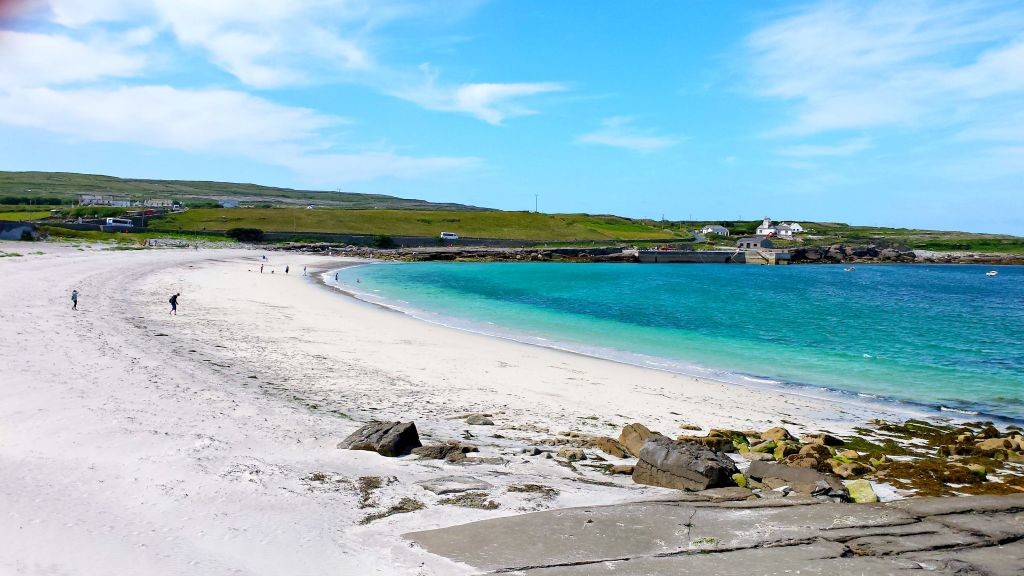
There are few people living on the Aran Islands, and very little traffic. Consequently, you will find peace and tranquillity on these isles, especially after the tourists depart on the afternoon ferry. If you’re looking to escape from the hustle and bustle of modern life, then stay overnight. Spend the evening at the local pub, meet the locals and enjoy some Irish music and great craic.
Are you a fan of Ireland’s beloved comedy sitcom Father Ted? Inis Mór is considered to be the real ‘Craggy Island’, although the aerial shot at the beginning of the show is actually of Inis Oírr. Every year a Friends of Ted Festival, or ‘Tedfest’, hold a fan convention on Inis Mór for fans to celebrate their love of Father Ted. For more information about Tedfest go to tedfest.org.
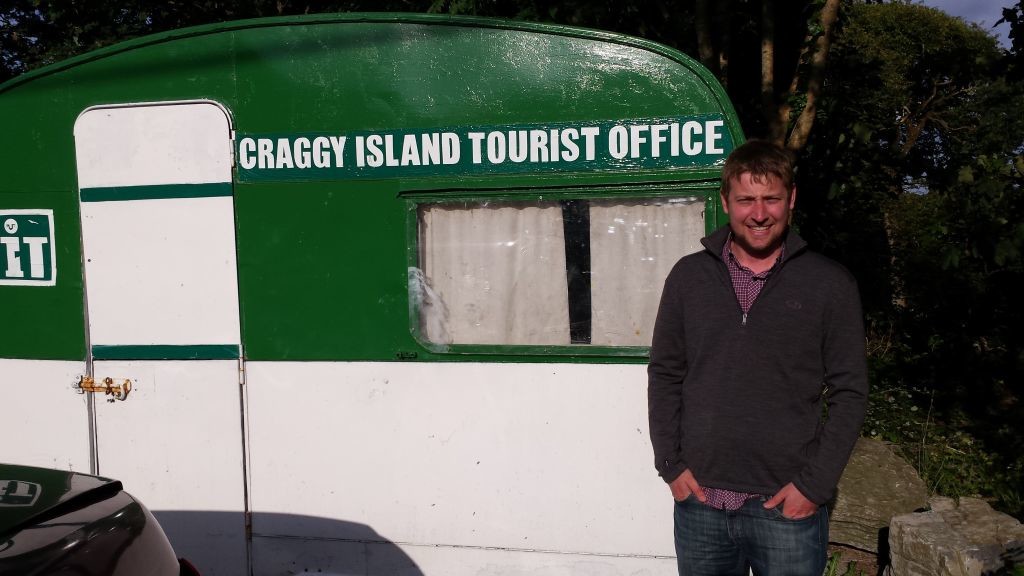
- In the summer months the islands get busy, so book in advance to guarantee your tours, ferry, and accommodation.
- Take cash – there are no cash machines on the smaller islands and limited ability to pay with card.
- I’ve added some links to some walks available on each of the Islands, but if you want a more detailed guide, then I recommend The Burren and The Aran Islands – A Walking Guide. It gives detailed information about the environment, plants, animals and history.
- If you want to learn more about the Aran Islands history, check out Tim Robinson’s Stones Of Aran which provides a wealth of information about the island’s folklore, wildlife, names, habitations, and natural and human histories.
- Visit the local pubs and enjoy the traditional Irish musicians playing.
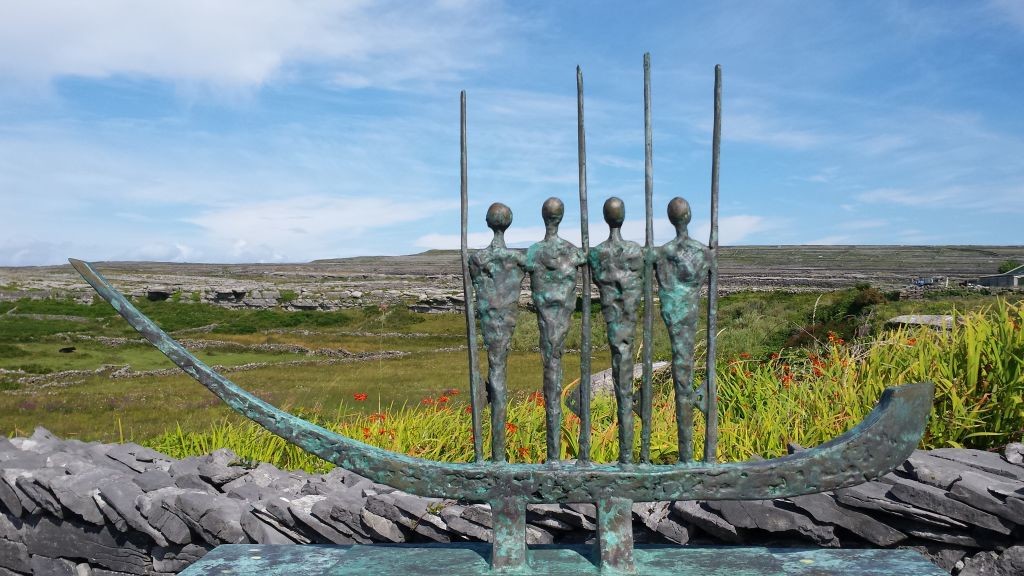
How to Get to the Aran Islands
Ferry
The ferries depart from two piers, Ros a’ Mhíl (Rossaveal) and Doolin. If you’re planning to stay overnight on the islands, you can park your car overnight in the pier car parks. Although these are not areas with high crime rate, you still need to ensure that you take your valuables with you or at least secure them out of sight.
Departing From Ros a’ Mhíl (Rossaveal)
Parking is available at the Ferry Car Park which is on the T-junction just before the pier.
The Aran Island Ferry runs services departing from Ros a’ Mhíl (Rossaveal) to all three Aran Islands. It is recommended that you book your ferry ticket in advance. If you don’t want to park your car at the ferry terminal, or you don’t have transport to the pier, then the Aran Island Ferry also operates a shuttle bus service that departs from Galway and makes pick-ups along the way.
Departing From Doolin
Doolin has a brand new pier and there is plenty of car parking available.
If you don’t have transport, then Bus Éireann run scheduled bus services to Doolin.
Ferries run from March to November.
Book online or purchase tickets at the main ticket office located on Doolin Pier. Doolin2Aran Ferries office will be directly facing you as you approach the pier – the building on the right, closest to the boarding area.
Ferries run from April to October.
Book online or purchase tickets at the main ticket office located on Doolin Pier.
Flights
Aer Arann Islands operate flights departing from Connemara Airport in Inverin, 19 miles West of Galway City on the R336. If you don’t have your own transport then for a small fee you can utilise their minibus service from the Victoria Hotel, Victoria Place, which is just off Eyre Square. You must book the minibus when booking your flight. Visit their website for flight information and bus times.
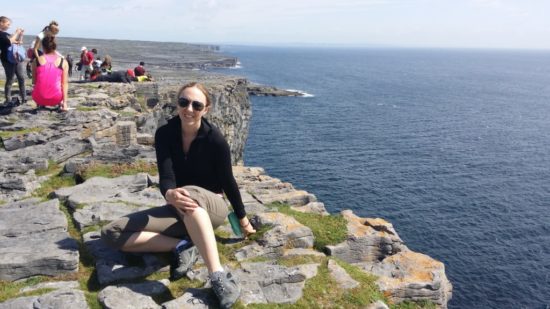
Inis Mór (Inishmore)
Inis Mór (Inishmore) is the largest of the Aran Islands and is a popular place to visit with many famous, spectacular, historical sights. The ferry docks in Inis Mór’s main town, Kilronan, which has several pubs, a small grocery store and some gift stores. It is also home to the famous Aran Island Sweater Market.
Information Centre
The Aran Tourist office is located in Kilronan village and can also be contacted by phone: +353 99 61263 and email: aran@failteireland.ie.
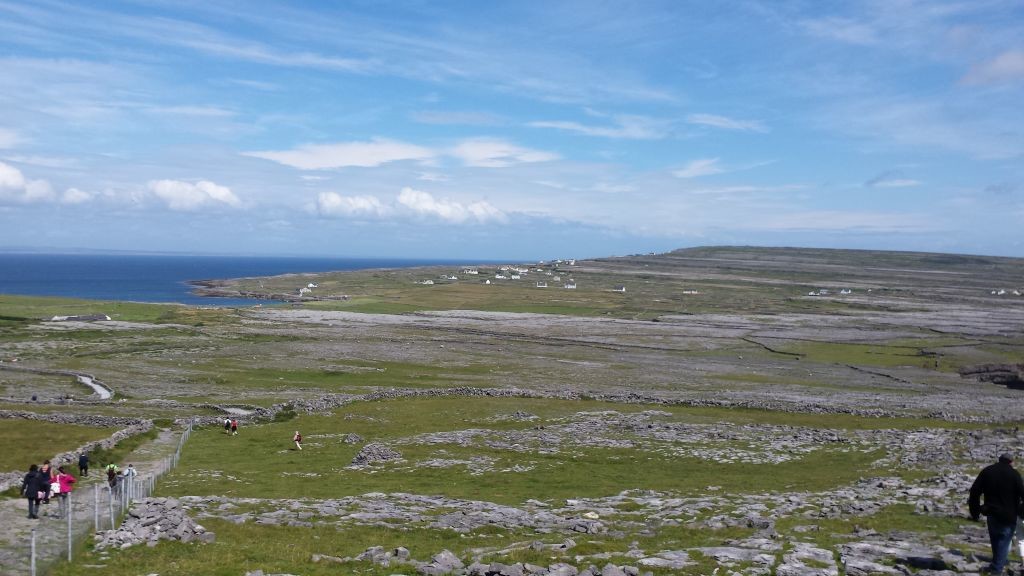
Accommodation
Inis Mór has a good range of accommodation options to suit all budgets, including B&B’s, Guesthouses, hotels and hostels which can be booked online.
Click here to search all available accommodation in Inis Mór.
Budget
There is a limited range of accommodation on the Island. None of it is particularly budget friendly, but this is the list of some of the cheapest accommodation on the Island.
Moderate
- Aran Islands Hotel
- Tigh Fitz Bed & Breakfast
- Pier House Guesthouse & Restaurant
- Aonghasa’s Walker’s Lodge
Luxury
There is good quality accommodation on Inis Mór, however, it is limited and I wouldn’t classify any as ‘luxury’.
Food and Drink
Inis Mór has a number of excellent café’s, pubs and restaurants to choose from, many serving traditional, home cooked meals.
Getting Around
Bicycle Hire
Hiring a bike for the day is a cheap and fun way to get around the Inis Mór and its sights. There are several bike rentals to choose from and you’ll find them around the pier at Kilronan (where the ferry arrives).
Pony and Trap
Pony and traps are a popular way to tour Inis Mór using the traditional mode of transport. There are several operators on the Island and they begin their tours from Kilronan where the ferry arrives.
Mini Bus Tours
A mini bus tour is a great option for those with limited mobility, and also if the weather’s bad or if you’re short on time. There are a number of mini-bus tour operators on the island and they begin their tours from Kilronan where the ferry arrives.
Walking
Inis Mór is approximately 14kms (8.7 miles) in length and 3.8kms (2.4 miles) in width. It’s an excellent place to enjoy hiking, but if you’re short on time a bike or mini bus tour will enable you to see more.
Walking suggestions:
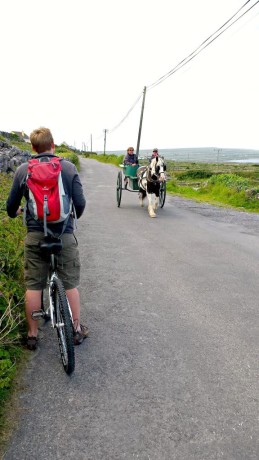
Attractions
There is so much to see and do on Inis Mór that it will easily fill your entire day.
- Aran Island Sweater Market
Located in Kilronan village, the Aran Island Sweater Market is famous all over the world for its high quality Aran Sweaters.
- Ionad Árainn (Heritage Centre)
Located three minutes walk from Kilronan village, the Heritage Centre’s exhibitions will take you through more than two thousand years of Aran Islands history and culture.
- Kilmurvey Blue Flag Beach
If you are lucky to visit Inis Mór on a sunny day, then Kilmurvey Beach is a great place to stop and rest, especially if you are cycling around the Island. You’ll find it just off the road between Kilronan and Dun Aengus. It may not be warm enough to completely jump in for a swim (although many do), but you will enjoy cooling your feet off in the refreshing blue water and relaxing on the beautiful, white, sandy beach.
- Kilmurvery Craft Village
Located at the foot of Dún Aonghasa, it contains an eclectic mix of Irish Arts and crafts shops. Many visitors to the island browse through before entering Dun Aonghasa.
- Dún Aonghasa (Dun Aengus)
Dún Aonghasa is a semi circular stone fort. The 14 acre fort consists of three terraced walls surrounding an inner enclosure containing a platform on the edge of a 90m high sea cliff, providing you with dramatic views. Some scholars suggest that this platform may have had ritual significance. Excavations carried out indicate that people were living here from c.1500BC, with the first walls and dwelling houses being erected c.1100BC. To get there, leave your bike at the bike racks provided outside the Visitor Centre and pay for your admission before heading up to the fort by foot. The path is an uphill walk of about 900m which takes about 20-30min.
- Dún Eochla (Stone Fort)
Located in the centre of the Island, this prehistoric stone ring fort features 5m high and 3m wide inner walls. It’s positioned on the highest point of the Island which provides visitors with wonderful views of the surrounding area. It’s often overlooked due to the popularity of Dún Aonghasa, but definitely worth a visit.
- Na Seacht d’Teampaill (The Seven Churches)
Despite its name, the site comprises of only two churches, Teampall Bhreacáin (St Brecan’s Church) and Teampall an Phoill (the Church of the Hollow), and several domestic buildings. Located at the village of Eoghanacht, the Seven Churches was for centuries one of the biggest monastic foundations and centres of pilgrimage along the west coast of Ireland.
- Dún Dúchathair (The Black Fort)
Situated on the cliffs at Cill Éinne (Killeany), this fort is more peaceful to visit as it gets much fewer visitors than Dún Aonghasa. The fort consists of a terraced wall surrounding the remains of some early dwelling houses known as Clocháns (stone houses). The name, Black Fort, comes from the dark coloured limestone which is characteristic of this particular area of the island.
- Dún Eoghanachta (Stone Fort)
This ring fort is found in the western head of the island in the townland of Eoghanacht, south of the village of Sruthán. It consists of a tall circular single two terraced wall. There are the remains of several Clocháin (stone houses) inside. The fort takes its name from the Eoghanacht tribe of Munster who were associated with the island in medieval times. Exact dates are not known but it is probably Iron Age.
- Clochán na Carraige (Beehive Hut)
Clochán na Carraige, situated near Cill Mhuirbihigh, is one of the best examples of a stone beehive hut in Ireland. These stone houses are unusual as they are oval shaped outside yet inside are rectangular.
Inis Meáin Island (Inishmaan)
Inis Meáin (Inishmaan) is the middle Aran Island and has a small population of 200 people. It is the least visited of the three islands, making it a tranquil getaway. Its interesting features include historical monuments, cultural heritage and, thanks to its hilly landscape, excellent views of the Cliffs of Moher. Irish is prevalently spoken, and people engage in farming and fishing in traditional currachs. You may also see people wearing traditional clothing.
There is only one pub in Inis Meáin, Teach Ósta. Teach Ósta is a 200-yr-old thatched cottage that was converted into the local pub in 1895. It’s a site worth seeing and a pub worth visiting.
Information Centre
You can access information from the Inis Meáin Cooperative near the post office in the centre of the island. They can be contacted by phone: +353 99 73010.
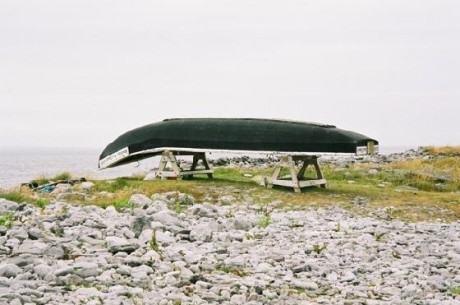
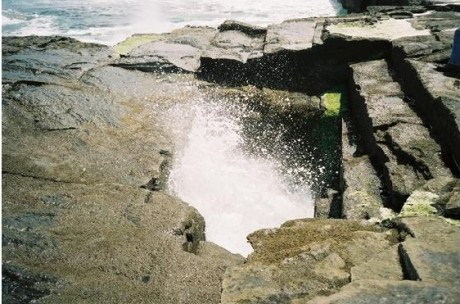
Accommodation
A small range of hotel, B&B’s and guesthouse accommodation is available on the island. When travelling to Inis Meáin it is recommended that you would organise accommodation in advance.
Food and Drink
Inis Meáin has one pub, Teach Ósta, which has good pub food and traditional atmosphere. There are several restaurants run by B&B’s that serve excellent home cooked meals.
Getting Around
Bicycle Hire
Inis Meáin is a hilly Island, but if you’re up to it, it’s a beautiful place to cycle around. Bike hire is available by the Pier.
Mini Bus Tours
A mini bus tour is a great option for those with limited mobility, if the weather’s bad or if you’re short on time. Mini bus tours can be accessed by the pier.
Walking
Inis Meáin is an excellent place to enjoy hiking. The hills reward walkers with beautiful views.
Walking suggestions:
Attractions
- Inis Meáin Knitting Co.
This local knitwear factory produces local handmade knitwear such as Aran Sweaters. They export their quality wares internationally, but you can purchase these beautiful knits direct from the factory at discount prices.
- Cliffs and the Puffing Holes
The cliffs of Inis Meáin are wonderfully dramatic and offer views of Inis Mor and the Cliffs of Moher. During the winter, the waves can become huge and rise up above the cliff face. On the days when the sea is rough, the water comes rushing up through blow holes, making a loud puffing sound and spraying icy seawater everywhere.
- Cathaoir Synge (Synge’s Chair) & Teach Synge (Synge House)
Inis Meáin is famous for providing a retreat for Ireland’s famous playwright, Edward John Millington Synge (1871-1909). Synge is the author of the plays Riders To The Sea, The Playboy of The Western World, and the moving account of life on the islands The Aran Islands. The cottage that Synge resided in, ‘Teach Synge’, has been refurbished with an adjoining library where memorabilia can be purchased. The cliff point facing Inis Mór is home to ‘Synge’s Chair’ and was where he regularly came to write and be inspired.
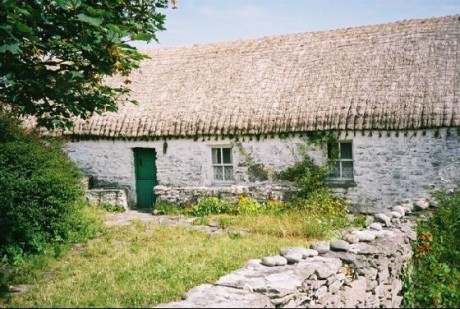
- The Church of Mary Immaculate
Nearby is the Church famed for its magnificent stained-glass windows. These were designed by the Harry Clarke studio and the alter was designed by Padraig Pearse’s father. (Padraig Pearse’s was one of the leaders of the Easter Rising in 1916).
- The Heritage House
The Heritage House is a gorgeous thatched cottage containing artefacts of historical value to Inis Meáin.
- Dún Crocbhur (Conor’s Fort)
Dún Crocbhur is the largest oval stone fort on all of the Aran Islands and measures 70m by 35m and up to 7m in height. It stands at the highest point of the island which provides visitors with dramatic views.
- Dún Fearbhaí (Ferboy’s Fort)
Although this stone fort dates from the 1st-7th century AD, it’s still in surprisingly good condition. It was used for defensive and ceremonial purposes and the structure is unusual in that it is square rather that the usual round type.
- Leaba Chinnderig – Saint Kenderrig’s Grave
This site is located directly behind the priest’s house which is in the centre of the island. It’s dated from the 7th century and is said to be the resting place of a Leinster Princess. Each year on the 15th of August the Inis Meáin locals gather for a pilgrimage to the grave and Saint Kenderig’s Well in the field next door.
- Teampall na Seacht Mac Rí (Church of The Seven Sons)
Unfortunately very little of this early church remains. The saint from whom this church derives its name is buried beside the church at the door to the south. In the past the church was an important place of pilgrimage for both island people and pilgrims from the mainland. Mass is still held here during the islands annual pilgrimage on the 15th August.
Inis Oírr (Inisheer)
Inis Oírr (Inisheer) is the smallest island and provides visitors the experience of a traditional and isolated Irish fishing village. It has a number of interesting features including historical monuments and cultural heritage.
Inis Oírr is fortunate to have a stunning beach located adjacent to the pier and on the edge of the main village. Largely uncrowded, its clean sandy beach and clear, blue and unspoilt water, which is sheltered and safe is a great place for swimming. Here, you will also get a chance to see the currachs (traditional fishing boats), nets, and fisherman returning at the end of the day with their catch.
The main village is located just near the pier and the beach and is nestled below the old light house and O’Brien’s fort. The local Traditional Music bar has the widely held belief that its one of the best in Ireland.
Information Centre
You can access information from the Inis Oírr Cooperative beyond the east end of the beach. They can be contacted by phone: +353 99 75008 and email: info@discoverinisoirr.ie.
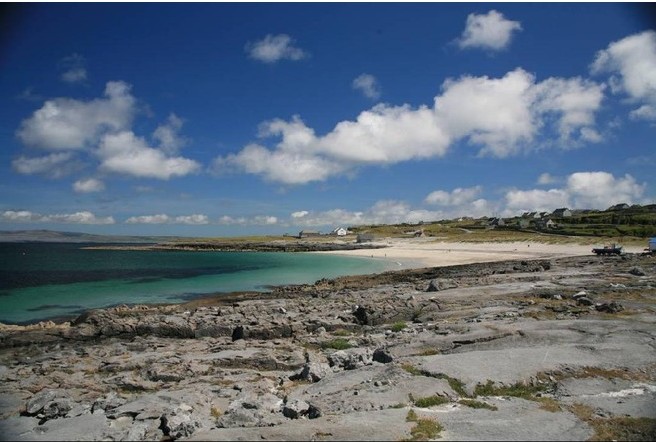
Accommodation
Inis Oírr has a range of accommodation options to suit all budgets, from a hostel, hotel and a number of B&B’s and Guesthouses.
Food and Drink
There is a restaurant, several pubs and cafés on the island.
Getting Around
Bicycle Hire
Hiring a bike for the day is a cheap and fun way to get around the Island and see its sights. Bike rental is available by the pier.
Pony and Trap
Pony and traps are a popular way to tour Inis Oírr using the traditional mode of transport. You can hire a pony and trap tour near the pier.
Mini Bus Tours
A mini bus tour is a great option for those with limited mobility, if the weather’s bad or if you’re short on time. You can hire a mini bus tour near the pier.
Walking
A full island walk would take at least a day. You can take off on your own or you can take this looped walk:
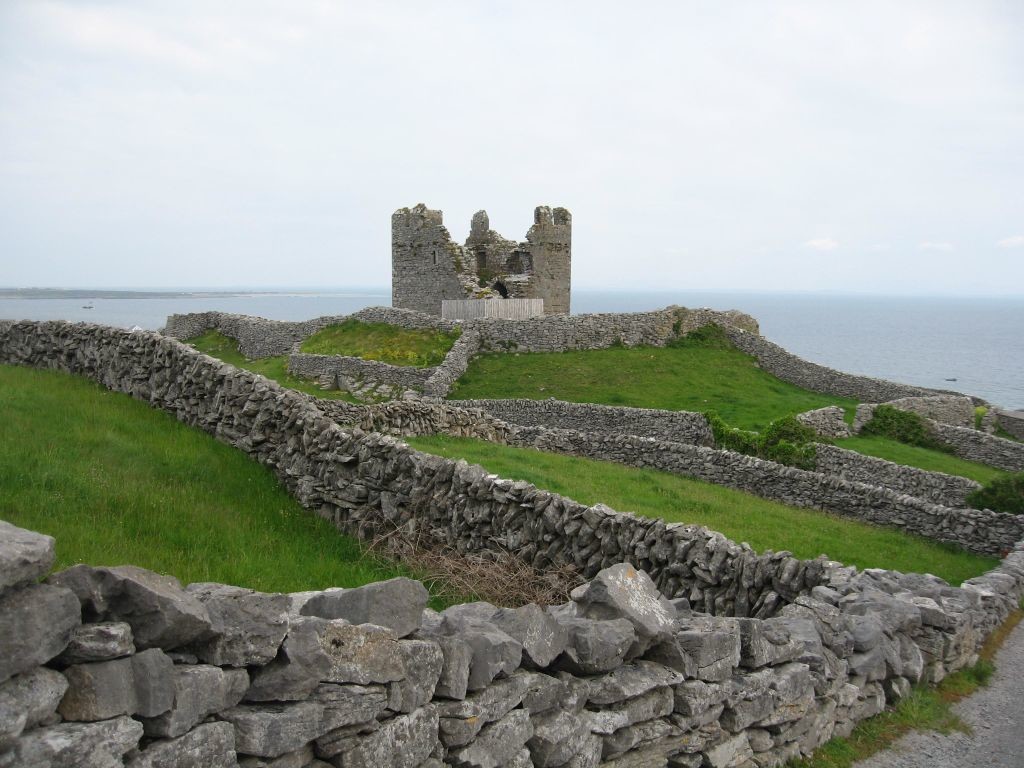
Attractions
- The Plassey Wreck
The Plassey is a rusty red shipwreck on the south eastern tip of the island. It’s a popular attraction on Inis Oírr and a spectacular sight. The Plassey was formerly a cargo ship which ran onto some rocks and beached near Inis Oírr in 1960. Thanks to the bravery of the local islanders, no lives were lost in the shipwreck.
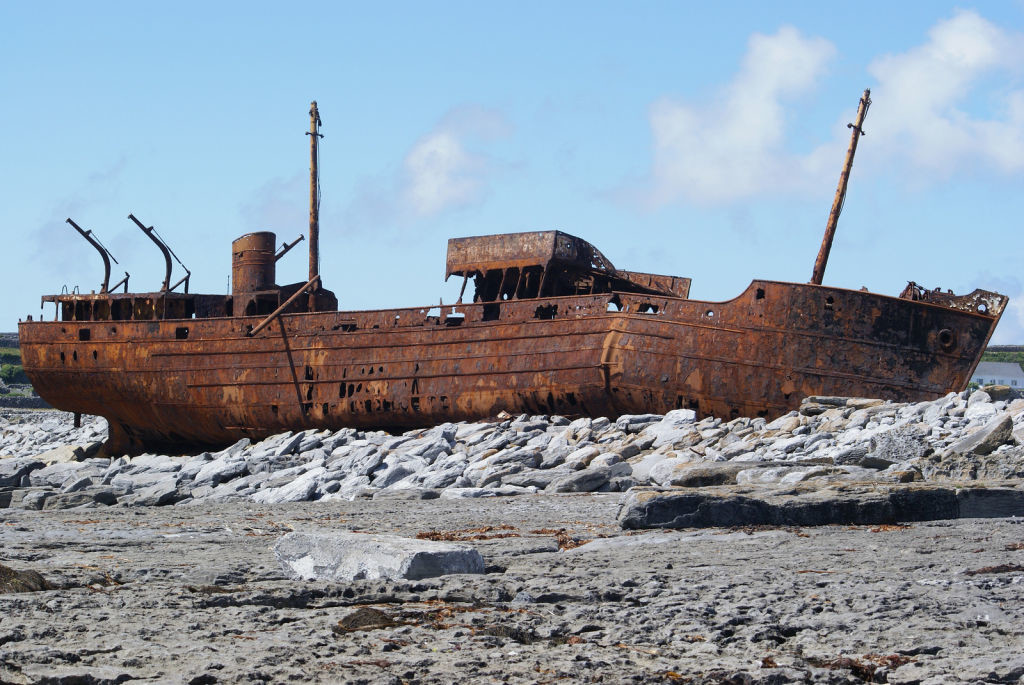
- Loch Mór (Big Lake)
Located on the road to the Plassey Shipwreck, Loch Mór is the islands only freshwater lake. Surrounded by foliage, it’s a beautiful and peaceful spot to rest and enjoy.
- Cill Ghobnait – An Teampall Beag (The Small Church)
This little church situated to the west of the pier dates from the 8th or 9th century. It’s dedicated to St. Gobnait, the defender of Ballyvourney. Gobnait came to Inis Oírr from County Clare to flee from enemies. She later went on to Ballyvourney. Nearby is a ‘beehive’ dry stone hut, referred to as a clochán, which were used as homes by early Christian monks.
- Cnoc Raithní
This prehistoric stone mound is close to the ferry port. The mound is an ancient burial ground and important artifacts including a bronze pin and jars containing cremated human bones were found here. The remains have been dated at 1500BC.
- The Lighthouse
The lighthouse was opened in 1857 and is located at the highest point of the island. It offers spectacular panoramic views.
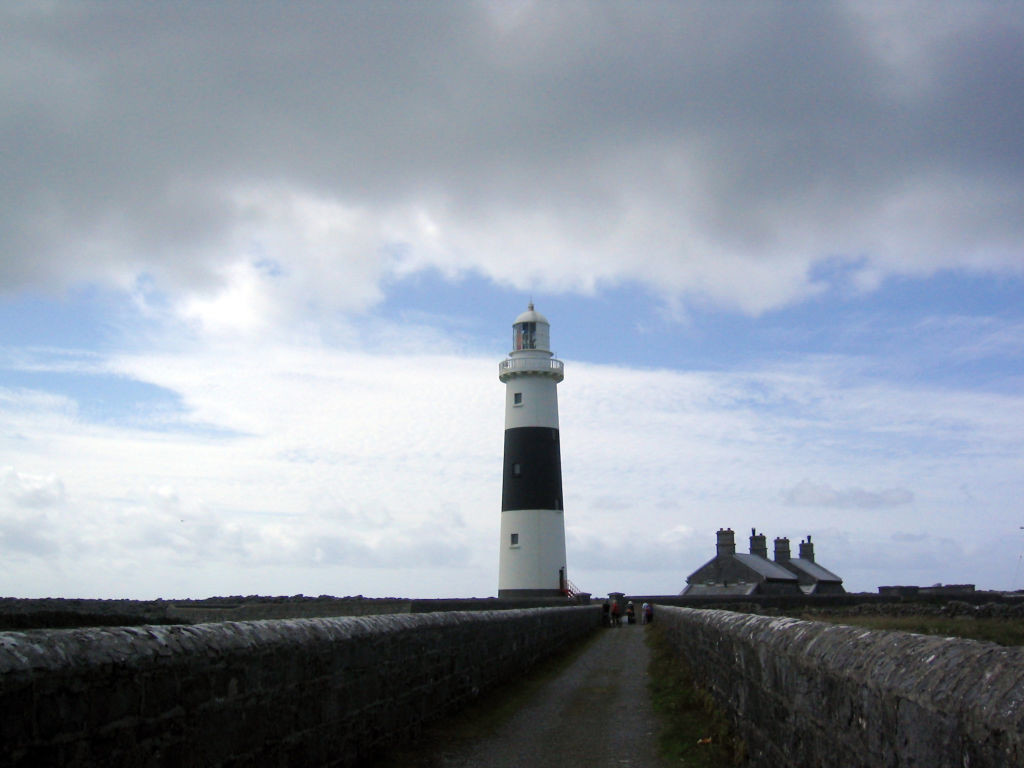
- Caislean Ui Bhriain & Dún Fhormna (O’Brien’s Castle)
This large three story castle was originally built by the O’Brien family who owned Inis Oírr up until 1585, when they were defeated by the O’Flaherty Clan. The castle occupies the approximate centre of an earlier Iron Age stone fort known as Dun Formna. The ruins of the castle can be easily reached from the pier by heading to the small village of Baile an Chaisleáin (Castle Town). While there, it’s also worth visiting the signal tower just a few metres up the hill.
- Teampall Chaomhán (St. Kevin’s Church)
The church ruins date back to the 10-14th century. Its graveyard contains the grave of the patron saint of the island, Caomhán. Caomhán was a disciple of St. Enda and each year, on the 14th of June, a festival is celebrated in St. Caomhán’s honour.
- Tobar Éanna (St. Enda’s Well)
Ruins of a holy well that was built in the honour of St. Éanna, the patron saint of Inis Mór.
Practical Tips for Visiting the Aran Islands
- How long should I stay for? You can visit Aran Islands on a day trip, but I recommend staying overnight to enjoy the peace and quiet once the tourists leave for the day.
- Language: English
- Currency: Euro
- Tipping: Not required, but people usually round up.
- Electricity: The electrical current is 230 volts AC. Wall outlets take a three pronged plug only used in Ireland and the United Kingdom. However, you are better off purchasing a
worldwide adaptor with USB ports that can be used in the Ireland as well other countries. At least then you can potentially get some further use out of it on future vacations.
- Driving: In Ireland they drive on the left hand side of the road with speed signs in kilometres per hour. Read my post on How to Drive Around Ireland. If you are planning on renting a vehicle, then read What to Expect When Renting a Vehicle in Ireland.
- Navigating: We used Google’s free Offline Maps. Google Offline Maps allows you to access free maps for navigating that can be used offline i.e. you don’t need WIFI, data, or roaming to be able to use them. Follow this detailed guide on how to use Googles Offline Maps. Warning: Both phone reception and mobile networks can be patchy. Even if you do have a data plan in Ireland, DON’T rely on being able to access the mobile networks to access Google online maps. Make sure you download a map to use when you find yourself without internet.
- Using your phone as a GPS will drain your battery quickly, so use a portable charger which you can use to charge your phone and any other chargeable devices.
- And finally, you could also purchase an Irish road map. At least it’s reliable and won’t run out of battery or malfunction like the electronic options!
- Wondering what to pack? This is a list of essential items that I packed for my trip around Ireland.



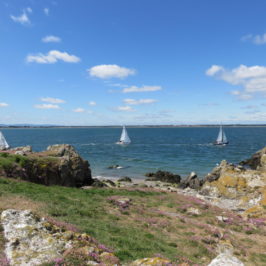
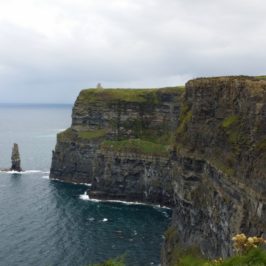
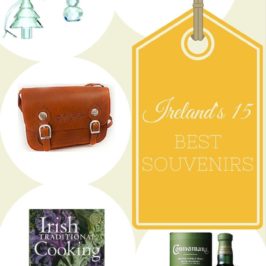
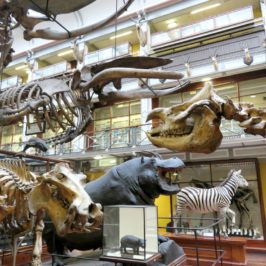
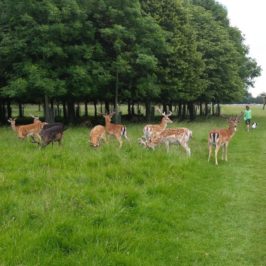
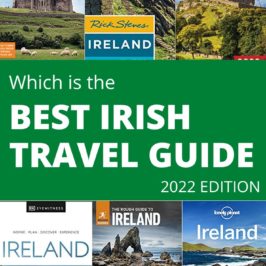
Leave a Reply